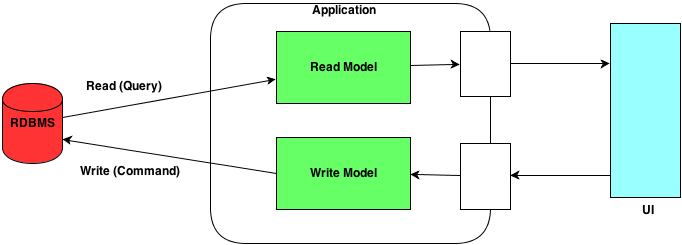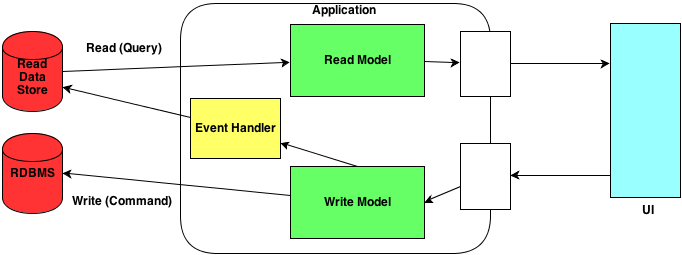Introduction
The ‘Command and Query Responsibility Segregation’ (CQRS) design pattern is based on the “Command-Query Separation” (CQS) principle from the book “Object-Oriented Software Construction“ by Bertrand Meyer (1988) and was first mentioned by Greg Young and Udi Dahan in 2010.
This pattern has produced a lot of excitement and hype but the principle behind it is very simple.
As the demands on command methods (any method with write access that mutates state) are usually very different to those on query methods (any method with read access that returns a value), it makes sense to separate these two groups. This would naturally mean different services but might also mean different models.
BookService
public interface BookService {
public Book getBook(int bookId);
public Book findBook(String isbn);
public void createBook(Book book);
public void updateBook(Book book);
public void deleteBook(int bookId);
}
Using CQRS we could break this service down into two smaller services:
BookWriteService
public interface BookWriteService {
public void createBook(Book book);
public void updateBook(Book book);
public void deleteBook(int bookId);
}
BookReadService
public interface BookReadService {
public Book getBook(int bookId);
public Book findBook(String isbn);
}
Doing so would enable us to make interesting architectural changes. We could for example separate the hosting of the two services. The write service could be hosted on one server while the read service could be hosted on many (ten for example).
This is especially true for the chosen example as the state of books rarely changes; there are few cases where a book would need to be updated.
That is the key concept of the ‘Command and Query Responsibility Segregation’ (CQRS) pattern: Take a traditional service and separate it into its read and write parts.
Taking the pattern further
Although the pattern itself is very simple it opens up interesting possibilities.
The standard CRUD (Create, Read, Update, and Delete) model looks something like this:

Applying the CQRS design pattern we can separate the service interface and create two different models. One for reading and one for writing:

Especially in cases of complicated domains this is an improvement on the traditional model as it enables the simplification of both models.
Based on the example above the BookWriteService and BookReadService can be split into:
CreateBookCommand (implements Command interface) UpdateBookCommand (implements Command interface) DeleteBookCommand (implements Command interface) GetBookQuery (implements Query interface) FindBookQuery (implements Query interface)
One problem that appears if the two models are running in different JVMs or on different hardware is keeping the data synchronized. In a case like this where models share the same database, it could be used to communicate between the two.
Going one step further we can add a separate data store for reading:

Here the full power of CQRS becomes visible: By separating the read and write data store steps the read operations can be optimized to the maximum on a software (de-normalization) and hardware level (adding extra servers).
The synchronization of the read and write data is done using an event handling mechanism.
The RDBMS would act here as the master database and the Read Data Store(s) would act as slave(s). The Read Data Store(s) could be completely rebuilt at any time using the RDBMS data.
For the read operations this architecture would be ideal for No-SQL databases (e.g. MongoDB, CouchDB, etc.) or OLAP-databases.
When to use the pattern
Though the concepts of CQRS are more and more widespread, big projects where it was successfully implemented are still quite rare. Martin Fowler wrote in July 2011:
Of course time has passed since 2011 but reference implementations are still hard to find.
When applying CQRS it should be taken into consideration that it might not be applicable to the system as a whole, so each portion of the system (“bounded context”) needs to be examined individually.
Event Sourcing and Task Based UI
Command and Query Responsibility Segregation can be applied on its own. However very often it is linked to further patterns. Here is a short summary of two of them:
Event Sourcing:
Event Sourcing can be described as the “capture of all changes to an application state as a sequence of events.” This represents a major shift in the way data is stored. Traditionally the contents of a database represented the present state of the application. A History of the changes was rarely available; at most a field “last modified date”.
Using Event Sourcing every change (event) is stored separately meaning that the data’s history is preserved. This makes for a much richer data source which, for example, could enable the generation of statistics on changes or the reconstruction of past states.
Link with CQRS: The main problem with Event Sourcing is that querying is complicated because it entails going through all the entries in the event log. By separating writing and querying CQRS supports the use of Event Sourcing on the write side.
Task Based UI:
Traditionally UI tasks are handled using DTOs. The DTO would be retrieved from the server and used to set up the state of the User Interface. The user would then make some changes and click on save.
A DTO (usually the same one) would then be sent back to the server. The problem with this method is that the intention of the user gets lost. In Task Based UI the initial behavior is the same (a DTO is retrieved from the server) but then instead of sending a DTO the application sends back messages (“commands”). This gives much more information about the behavior of the user.
Link with CQRS: Having two different models for command and query enables the use of Task Based UI.
Further study
There are a lot of resources available for CQRS. Most of them somehow combine “Command and Query Responsibility Segregation”, “Event Sourcing” and “Task Based UI”.
This page gives a nice overview of CQRS. The code snippets are in C# (.NET):
http://www.codeproject.com/Articles/555855/Introduction-to-CQRS
CQRS sample code in Java (using Spring and JPA) :
http://code.google.com/p/ddd-cqrs-sample/
Axon claims to be a “CQRS Framework for Java” (I have not tested it so cannot really comment):
http://www.axonframework.org/
References
http://en.wikipedia.org/wiki/Command%E2%80%93query_separation
http://martinfowler.com/bliki/CQRS.html
http://martinfowler.com/eaaDev/EventSourcing.html
http://martinfowler.com/bliki/CommandQuerySeparation.html
http://codebetter.com/gregyoung/2010/02/16/cqrs-task-based-uis-event-sourcing-agh/
http://codebetter.com/gregyoung/2010/02/20/why-use-event-sourcing/
http://codebetter.com/gregyoung/2010/02/13/cqrs-and-event-sourcing/
http://www.udidahan.com/2009/12/09/clarified-cqrs/
http://www.udidahan.com/2013/04/28/queries-patterns-and-search-food-for-thought/
http://captaincodeman.com/2010/03/31/homongous-mongodb-nosql-cqrs/
https://groups.google.com/forum/#!topic/dddcqrs/OYqkaSCLF9w
http://msdn.microsoft.com/en-us/library/jj591577.aspx
http://blog.excilys.com/2012/12/11/cqrs-lire-ou-ecrire-il-faut-choisir/
